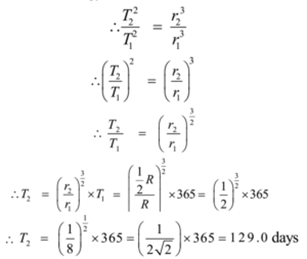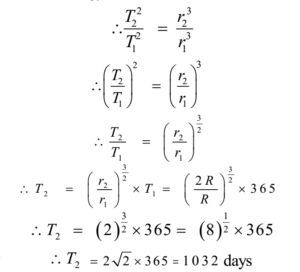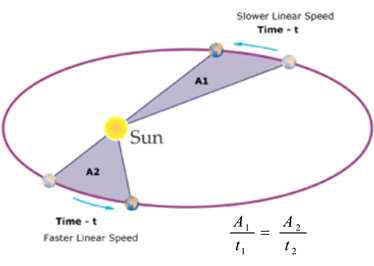Science > Physics > Gravitation > Numerical Problems on Keppler’s Laws
In this article we shall study numerical problems on Keppler’s third law of orbital motion, to calculate period of revolution of a planet around the sun.
Example – 01:
What would be the length of the year if the earth were at half its present distance from the sun?
Given: r2 = 1/2 r1, old period T1 = 365 days
To Find: New period T2 =?
Solution:
By Keppler’s law, we have T2 ∝ r3

Ans: Thus length of the year would be 129 days
Example – 02:
What would be the duration of the year if the distance of the Earth from the sun gets doubled?
Given: r2 = 2 r1, old period T1 = 365 days
To Find: New period T2 =?
Solution:
By Keppler’s law, we have T2 ∝ r3

Ans: Thus the length of the year would be 1032 days
Example – 03:
Calculate the period of revolution of the planet Jupiter around the Sun. The ratio of the radius of Jupiter’s orbit to that of earth’s orbit around the Sun is 5.2.
Given: rJ : re = 5.2 , Time period of the Earth T1 = 1 year.
To Find: Period of Jupiter TJ =?
Solution:
By Keppler’s law, we have T2 ∝ r3

Ans: The period of revolution of planet Jupiter is 11.86 years.
Example – 04:
A geostationary satellite is orbiting the earth at a height of 6R above its surface. What is the time period of a satellite orbiting at a height of 2.5 R above the earth’s surface? Where R is the radius of the Earth.
Solution:
Given: r1 = R + 6R = 7R, r2 = R + 2.5 R = 3.5 R, Time period of geostationary satellite T1 = 24 hours.
To Find: Period of second satellite T2 =?
By Keppler’s law, we have T2 ∝ r3

Ans: The period of revolution of a satellite orbiting at a height of 2.5 R above the earth’s surface is 8.458 hr.
Example – 05:
A satellite orbiting around the earth has a period of 8 hrs. If the distance of another satellite from the centre of the earth is four times that of above, what is its period?
Given: Ratio of radii of orbits r1 = r, r2 = 4r, Time period of first satellite T1 = 8 hours.
To Find: Period of second satellite T2 =?
Solution:
By Keppler’s law, we have T2 ∝ r3

Ans: The period of the second satellite is 64 hours.
Example – 06:
Calculate the period of revolution of a planet around the sun if the diameter of its orbit is 60 times that of Earth’s orbit around the Sun. Assume both orbits to be circular.
Given: dP = 60 dE, rP = 60 rE, Time period of Earth TE = 1 year.
To Find: Period of the planet TP =?
Solution:
By Keppler’s law, we have T2 ∝ r3

Ans: The period of the planet is 464.8 years
Example – 07:
The planet Neptune travels around the sun with a period of 165 years. Show that the radius of its orbit is approximately thirty times that of the Earth.
Given: Period of NeptuneTN = 165 years, Time period of Earth TE = 1 year.
To Show: Radius of Neptune rN =30 rE
Solution:
By Keppler’s law, we have T2 ∝ r3

Ans: Thus the radius of its orbit is approximately thirty times that of the Earth.
Example – 08:
The radius of earth’s orbit is 1.5 ×108 km and that of mars is 2.5 × 1011 m. in how many years the mars completes its one revolution.
Given: Radius of the orbit of the Earth rE = 1.5 ×108 km = 1.5 ×1011 m, Radius of the orbit of the Mars rM = 2.5 ×1011 m, Time period of Earth TE = 1 year.
To Find: Time period of Mars TM =?
Solution:
By Keppler’s law, we have T2 ∝ r3

TM = 2.15 years
Ans: In 2.15 years Mars completes its one revolution.
Example – 09:
The mean distance of the earth from the Sun is 1.496 ×108 km and its period of revolution around the Sun is 365.3 days. The time periods of revolutions of planets Venus and Mars are 224.7 days and 687.0 days respectively, where day means a terrestrial day. Calculate the distances of Venus and Mars from the Sun.
Given: Radius of the orbit of the Earth rE = 1.496 ×108 km, Time period of Earth TE = 365.3 days, Time period of Venus TE = 224.7 days, Time period of Mars TM = 687.0 days.
To Show: Radius of the orbit of the Venus rV =? Radius of the orbit of the Mars rM = ?,
Solution:
By Keppler’s law, we have T2 ∝ r3

Ans: Distance of Venus from the sun is 1.08 ×108 km and distance of Mars from the sun is 2.279 ×108 km
Example – 10
Suppose Earth’s orbital motion around the Sun is suddenly stopped. What time the Earth shall take to fall into the Sun.
Given: Radius of the orbit of the Earth = r, Time period of Earth T = 365 days,
To Show: Time taken by the Earth to fall into the Sun T2 = ?,
Solution:
In this problem, we are assuming there is no effect of temperature on the Earth. If the Earth suddenly stops rotating around the sun and falls into the sun and let us assume it comes back to the point on the orbit. Thus it starts orbiting along a highly flattened ellipse with major axis = r. Thus semimajor axis = a = r2 = r/2
By Keppler’s law, we have T2 ∝ r3

This is the total period of revolution. It should take half the time period to fall into the Sun
Time required = 130/2 = 65 days
Ans: Earth shall take 65 days to fall into the Sun.
Note: Thus, in general, the time taken by a planet to fall into the sun = Period x 0.1768 (This relation can be used for MCQ)
Previous Topic: Keppler’s Laws of Orbital Motion
Next Topic: Satellites and Their Uses

2 replies on “Numerical Problems on Keppler’s Laws”
This is really helping I’m inspired by what I have found on this page, it’s too encouraging and hoping to work with you in my everyday worksheets.
This Is Interested.